Microwave-Assisted Rapid Synthesis of Eu(OH)3/RGO Nanocomposites and Enhancement of Their Antibacterial Activity against Escherichia coli
Abstract
:1. Introduction
2. Materials and Methods
2.1. Materials Used
2.2. Synthesis of the Eu(OH)3/RGO Nanocomposites
2.3. Characterization
2.4. Antibacterial Ability of Eu(OH)3/RGO
2.4.1. Culture Medium and Culture Conditions
2.4.2. Minimum Inhibitory Concentration (MIC)
2.4.3. Colony Counting Method
2.4.4. Optical Density (O.D.)
2.4.5. Inhibition Zone
2.4.6. Reutilization Experiment
2.4.7. Statistical Analysis
3. Results and Discussion
3.1. Characterization of Eu(OH)3/RGO
3.1.1. XRD Analysis
3.1.2. Raman Spectroscopy
3.1.3. FTIR Spectroscopy
3.1.4. Morphological Characterization
3.1.5. Fluorescence Properties
3.2. MIC
3.3. Optical Density
3.4. Colony Counting Method
3.5. Inhibition Zone
3.6. Reusability of Eu(OH)3/RGO Nanocomposites
4. Conclusions
Author Contributions
Funding
Institutional Review Board Statement
Informed Consent Statement
Data Availability Statement
Conflicts of Interest
References
- Owhal, A.; Pingale, A.D.; Belgamwar, S.U.; Rathore, J.S. A brief manifestation of anti-bacterial nanofiller reinforced coatings against the microbial growth based novel engineering problems. Mater. Today Proc. 2021, 47, 3320–3330. [Google Scholar] [CrossRef]
- Flandroy, L.; Poutahidis, T.; Berg, G.; Clarke, G.; Dao, M.-C.; Decaestecker, E.; Furman, E.; Haahtela, T.; Massart, S.; Plovier, H.; et al. The impact of human activities and lifestyles on the interlinked microbiota and health of humans and of ecosystems. Sci. Total. Environ. 2018, 627, 1018–1038. [Google Scholar] [CrossRef] [PubMed]
- Wang, S.; Wang, Y.; Peng, Y.; Yang, X. Exploring the Antibacteria Performance of Multicolor Ag, Au, and Cu Nanoclusters. ACS Appl. Mater. Interfaces 2019, 11, 8461–8469. [Google Scholar] [CrossRef]
- Huang, X.; Wang, D.; Hu, L.; Song, J.; Chen, Y. Preparation of a novel antibacterial coating precursor and its antibacterial mechanism. Appl. Surf. Sci. 2018, 465, 478–485. [Google Scholar] [CrossRef]
- Wu, Y.; Zang, Y.; Xu, L.; Wang, J.; Jia, H.; Miao, F. Synthesis of high-performance conjugated microporous polymer/TiO2 photocatalytic antibacterial nanocomposites. Mater. Sci. Eng. C 2021, 126, 112121. [Google Scholar] [CrossRef] [PubMed]
- Mahira, S.; Jain, A.; Khan, W.; Domb, A.J. Antimicrobial materials—An overview. In Antimicrobial Materials for Biomedical Applications; Domb, A.J., Kunduru, K.R., Farah, S.R., Eds.; Royal Society of Chemistry: London, UK, 2019; pp. 1–37. [Google Scholar]
- Ma, G.; Chen, Y.; Li, L.; Jiang, D.; Qiao, R.; Zhu, Y. An attractive photocatalytic inorganic antibacterial agent: Preparation and property of graphene/zinc ferrite/polyaniline composites. Mater. Lett. 2014, 131, 38–41. [Google Scholar] [CrossRef]
- Abdelhamid, H.N.; Talib, A.; Wu, H.-F. Facile synthesis of water soluble silver ferrite (AgFeO2) nanoparticles and their biological application as antibacterial agents. RSC Adv. 2015, 5, 34594–34602. [Google Scholar] [CrossRef]
- Kim, J.D.; Yun, H.; Kim, G.C.; Lee, C.W.; Choi, H.C. Antibacterial activity and reusability of CNT-Ag and GO-Ag nanocomposites. Appl. Surf. Sci. 2013, 283, 227–233. [Google Scholar] [CrossRef]
- Pauzi, N.; Zain, N.M.; Kutty, R.V.; Ramli, H. Antibacterial and antibiofilm properties of ZnO nanoparticles synthesis using gum arabic as a potential new generation antibacterial agent. Mater. Today Proc. 2020, 41, 1–8. [Google Scholar] [CrossRef]
- Pauzi, N.; Zain, N.M.; Yusof, N.A.A. Gum arabic as natural stabilizing agent in green synthesis of ZnO nanofluids for antibacterial application. J. Environ. Chem. Eng. 2020, 8, 108331. [Google Scholar] [CrossRef]
- Ahmadi, R.; Fatahi, R.F.N.; Sangpour, P.; Bagheri, M.; Rahimi, T. Evaluation of antibacterial behavior of in situ grown CuO-GO nanocomposites. Mater. Today Commun. 2021, 28, 102642. [Google Scholar] [CrossRef]
- Szunerits, S.; Boukherroub, R. Antibacterial activity of graphene-based materials. J. Mater. Chem. B 2016, 4, 6892–6912. [Google Scholar] [CrossRef] [PubMed] [Green Version]
- Zhu, Q.-L.; Xu, Q. Immobilization of Ultrafine Metal Nanoparticles to High-Surface-Area Materials and Their Catalytic Applications. Chem 2016, 1, 220–245. [Google Scholar] [CrossRef]
- Khan, A.U.; Khan, Q.U.; Tahir, K.; Ullah, S.; Arooj, A.; Li, B.; Rehman, K.U.; Nazir, S.; Khan, M.U.; Ullah, I. A Tagetes minuta based eco-benign synthesis of multifunctional Au/MgO nanocomposite with enhanced photocatalytic, antibacterial and DPPH scavenging activities. Mater. Sci. Eng. C 2021, 126, 112146. [Google Scholar] [CrossRef]
- Alavi, M.; Karimi, N. Ultrasound assisted-phytofabricated Fe3O4 NPs with antioxidant properties and antibacterial effects on growth, biofilm formation, and spreading ability of multidrug resistant bacteria. Artif. Cells Nanomed. Biotechnol. 2019, 47, 2405–2423. [Google Scholar] [CrossRef] [PubMed] [Green Version]
- Sekhar, D.C.; Diwakar, B.S.; Madhavi, N. Synthesis, characterization and anti-bacterial screening of complex nanocomposite structures of SiO2@ZnO@Fe3O4 and SnO2@ZnO@Fe3O4. Nano-Struct. Nano-Objects 2019, 19, 100374. [Google Scholar] [CrossRef]
- Thakur, N.; Kumar, K. Effect of (Ag, Co) co-doping on the structural and antibacterial efficiency of CuO nanoparticles: A rapid microwave assisted method. J. Environ. Chem. Eng. 2020, 8, 104011. [Google Scholar] [CrossRef]
- Yang, S.; Nie, Y.; Zhang, B.; Tang, X.; Mao, H. Construction of Er-doped ZnO/SiO2 composites with enhanced antimicrobial properties and analysis of antibacterial mechanism. Ceram. Int. 2020, 46, 20932–20942. [Google Scholar] [CrossRef]
- Mu, Q.; Wang, Y. A simple method to prepare Ln(OH)3 (Ln=La, Sm, Tb, Eu, and Gd) nanorods using CTAB micelle solution and their room temperature photoluminescence properties. J. Alloy. Compd. 2011, 509, 2060–2065. [Google Scholar] [CrossRef]
- Nethi, S.K.; Veeriah, V.; Barui, A.K.; Rajendran, S.; Mattapally, S.; Misra, S.; Chatterjee, S.; Patra, C.R. Investigation of molecular mechanisms and regulatory pathways of pro-angiogenic nanorods. Nanoscale 2015, 7, 9760–9770. [Google Scholar] [CrossRef] [Green Version]
- Cheng, Y.-W.; Wang, S.-H.; Liu, C.-M.; Chien, M.-Y.; Hsu, C.-C.; Liu, T.-Y. Amino-modified graphene oxide nanoplatelets for photo-thermal and anti-bacterial capability. Surf. Coat. Technol. 2020, 385, 125441. [Google Scholar] [CrossRef]
- Palmieri, V.; Lauriola, M.C.; Ciasca, G.; Conti, C.; De Spirito, M.; Papi, M. The graphene oxide contradictory effects against human pathogens. Nanotechnology 2017, 28, 152001. [Google Scholar] [CrossRef] [PubMed]
- Kashinath, L.; Namratha, K.; Byrappa, K. Microwave mediated synthesis and characterization of CeO2-GO hybrid composite for removal of chromium ions and its antibacterial efficiency. J. Environ. Sci. 2019, 76, 65–79. [Google Scholar] [CrossRef] [PubMed]
- Gao, W.; Alemany, L.B.; Ajayan, P.M. New insights into the structure and reduction of graphite oxide. Nat. Chem. 2009, 1, 403–408. [Google Scholar] [CrossRef] [PubMed]
- Shao, W.; Liu, X.; Min, H.; Dong, G.; Feng, Q.; Zuo, S. Preparation, Characterization, and Antibacterial Activity of Silver Nano-particle-Decorated Graphene Oxide Nanocomposite. ACS Appl. Mater. Interfaces 2015, 7, 6966–6973. [Google Scholar] [CrossRef]
- Ji, T.; Zhang, R.; Dong, X.; Sameen, D.E.; Ahmed, S.; Li, S.; Liu, Y. Effects of Ultrasonication Time on the Properties of Polyvinyl Alcohol/Sodium Carboxymethyl Cellulose/Nano-ZnO/Multilayer Graphene Nanoplatelet Composite Films. Nanomaterials 2020, 10, 1797. [Google Scholar] [CrossRef] [PubMed]
- Araújo, I.M.; Silva, R.R.; Pacheco, G.; Lustri, W.R.; Tercjak, A.; Gutierrez, J.; Júnior, J.R.; Azevedo, F.H.; Figuêredo, G.S.; Vega, M.L.; et al. Hydrothermal synthesis of bacterial cellulose–copper oxide nanocomposites and evaluation of their antimicrobial activity. Carbohydr. Polym. 2018, 179, 341–349. [Google Scholar] [CrossRef] [PubMed] [Green Version]
- Krishnan, B.; Mahalingam, S. Facile synthesis and antimicrobial activity of manganese oxide/bentonite nanocomposites. Res. Chem. Intermed. 2016, 43, 2351–2365. [Google Scholar] [CrossRef]
- Chegeni, M.; Pour, S.K.; Dizaji, B.F. Synthesis and characterization of novel antibacterial Sol-gel derived TiO2/Zn2TiO4/Ag nanocomposite as an active agent in Sunscreens. Ceram. Int. 2019, 45, 24413–24418. [Google Scholar] [CrossRef]
- Jing, Z.; Guo, D.; Wang, W.; Zhang, S.; Qi, W.; Ling, B. Comparative study of titania nanoparticles and nanotubes as antibacterial agents. Solid State Sci. 2011, 13, 1797–1803. [Google Scholar] [CrossRef]
- Dąbrowska, S.; Chudoba, T.; Wojnarowicz, J.; Łojkowski, W. Current Trends in the Development of Microwave Reactors for the Synthesis of Nanomaterials in Laboratories and Industries: A Review. Crystals 2018, 8, 379. [Google Scholar] [CrossRef] [Green Version]
- Chook, S.W.; Chia, C.H.; Zakaria, S.; Ayob, M.K.; Chee, K.L.; Huang, N.M.; Neoh, H.M.; Lim, H.N.; Jamal, R.; Rahman, R. Antibacterial performance of Ag nanoparticles and AgGO nanocomposites prepared via rapid microwave-assisted synthesis method. Nanoscale Res. Lett. 2012, 7, 541. [Google Scholar] [CrossRef] [PubMed] [Green Version]
- Fan, B.; Li, Y.; Han, F.; Su, T.; Li, J.; Zhang, R. Synthesis of Ag/rGO composite materials with antibacterial activities using facile and rapid microwave-assisted green route. J. Mater. Sci. Mater. Med. 2018, 29, 69. [Google Scholar] [CrossRef] [PubMed]
- Kannan, K.; Radhika, D.; Nikolova, M.P.; Andal, V.; Sadasivuni, K.K.; Krishna, L.S. Facile microwave-assisted synthesis of metal oxide CdO-CuO nanocomposite: Photocatalytic and antimicrobial enhancing properties. Optik 2020, 218, 165112. [Google Scholar] [CrossRef]
- Revathi, V.; Karthik, K. Microwave assisted CdO–ZnO–MgO nanocomposite and its photocatalytic and antibacterial studies. J. Mater. Sci. Mater. Electron. 2018, 29, 18519–18530. [Google Scholar] [CrossRef]
- Yu, S.-H.; Wang, Q.-L.; Chen, Y.; Wang, Y.; Wang, J.-H. Microwave-assisted synthesis of spinel ferrite nanospherolites. Mater. Lett. 2020, 278, 128431. [Google Scholar] [CrossRef]
- Lyubutin, I.; Baskakov, A.; Starchikov, S.; Shih, K.-Y.; Lin, C.-R.; Tseng, Y.-T.; Yang, S.-S.; Han, Z.-Y.; Ogarkova, Y.; Nikolaichik, V.; et al. Synthesis and characterization of graphene modified by iron oxide nanoparticles. Mater. Chem. Phys. 2018, 219, 411–420. [Google Scholar] [CrossRef]
- Shih, K.-Y.; Kuan, Y.-L.; Wang, E.-R. One-Step Microwave-Assisted Synthesis and Visible-Light Photocatalytic Activity Enhancement of BiOBr/RGO Nanocomposites for Degradation of Methylene Blue. Materials 2021, 14, 4577. [Google Scholar] [CrossRef]
- Ali, F.A.A.; Alam, J.; Shukla, A.K.; Alhoshan, M.; Ansari, M.A.; Al-Masry, W.A.; Rehman, S.; Alam, M. Evaluation of antibacterial and antifouling properties of silver-loaded GO polysulfone nanocomposite membrane against Escherichia coli, Staphylococcus aureus, and BSA protein. React. Funct. Polym. 2019, 140, 136–147. [Google Scholar] [CrossRef]
- Wang, J.; Gao, X.; Yu, H.; Wang, Q.; Ma, Z.; Li, Z.; Zhang, Y.; Gao, C. Accessing of graphene oxide (GO) nanofiltration membranes for microbial and fouling resistance. Sep. Purif. Technol. 2019, 215, 91–101. [Google Scholar] [CrossRef]
- Moghayedi, M.; Goharshadi, E.K.; Ghazvini, K.; Ahmadzadeh, H.; Ranjbaran, L.; Masoudi, R.; Ludwig, R. Kinetics and mechanism of antibacterial activity and cytotoxicity of Ag-RGO nanocomposite. Colloids Surf. B Biointerfaces 2017, 159, 366–374. [Google Scholar] [CrossRef] [PubMed]
- Kang, J.-G.; Jung, Y.; Min, B.-K.; Sohn, Y. Full characterization of Eu(OH)3 and Eu2O3 nanorods. Appl. Surf. Sci. 2014, 314, 158–165. [Google Scholar] [CrossRef]
- Wang, P.-P.; Bai, B.; Huang, L.; Hu, S.; Zhuang, J.; Wang, X. General synthesis and characterization of a family of layered lanthanide (Pr, Nd, Sm, Eu, and Gd) hydroxide nanowires. Nanoscale 2011, 3, 2529–2535. [Google Scholar] [CrossRef]
- Chen, P.; Xing, X.; Xie, H.; Sheng, Q.; Qu, H. High catalytic activity of magnetic CuFe2O4/graphene oxide composite for the degradation of organic dyes under visible light irradiation. Chem. Phys. Lett. 2016, 660, 176–181. [Google Scholar] [CrossRef]
- Park, J.; Kim, S.; Lee, G.; Choi, J. RGO-Coated TiO2 Microcones for High-Rate Lithium-Ion Batteries. ACS Omega 2018, 3, 10205–10210. [Google Scholar] [CrossRef]
- Gong, Y.; Li, D.; Fu, Q.; Pan, C. Influence of graphene microstructures on electrochemical performance for supercapacitors. Prog. Nat. Sci. Mater. Int. 2015, 25, 379–385. [Google Scholar] [CrossRef] [Green Version]
- Kang, J.-G.; Min, B.-K.; Sohn, Y. Synthesis and characterization of Sm(OH)3 and Sm2O3 nanoroll sticks. J. Mater. Sci. 2014, 50, 1958–1964. [Google Scholar] [CrossRef]
- Papailias, I.; Giannouri, M.; Trapalis, A.; Todorova, N.; Giannakopoulou, T.; Boukos, N.; Lekakou, C. Decoration of crumpled rGO sheets with Ag nanoparticles by spray pyrolysis. Appl. Surf. Sci. 2015, 358, 84–90. [Google Scholar] [CrossRef]
- Mehdi, M.K.; Sakineh, A.; Fateme, A.; Masoud, S.N. A controllable hydrothermal method to prepare La(OH)3 nanorods using new precursors. J. Rare Earths 2015, 33, 425–431. [Google Scholar]
- Shi, Y.; Dong, C.; Shi, J. Influence of different synthesis methods on structure, morphology and luminescent properties of BiOCl: Eu3+ phosphors and J–O analysis. J. Mater. Sci. Mater. Electron. 2017, 29, 186–194. [Google Scholar] [CrossRef]
- Kattel, K.; Park, J.Y.; Xu, W.; Alam Bony, B.; Heo, W.C.; Tegafaw, T.; Kim, C.R.; Ahmad, M.W.; Jin, S.; Baeck, J.S.; et al. Surface coated Eu(OH)3 nanorods: A facile synthesis, characterization, MR relaxivities and in vitro cytotoxicity. J. Nanosci. Nanotechnol. 2013, 13, 7214–7219. [Google Scholar] [CrossRef] [PubMed]
- Wong, K.-L.; Law, G.-L.; Murphy, M.B.; Tanner, P.A.; Wong, W.-T.; Lam, P.K.-S.; Lam, M.H.-W. Functionalized Europium Nanorods for In Vitro Imaging. Inorg. Chem. 2008, 47, 5190–5196. [Google Scholar] [CrossRef] [PubMed]
- Anuj, S.A.; Gajera, H.P.; Hirpara, D.G.; Golakiya, B.A. Interruption in membrane permeability of drug-resistant Staphylococcus aureus with cationic particles of nano-silver. Eur. J. Pharm. Sci. 2018, 127, 208–216. [Google Scholar] [CrossRef]
- Karthik, K.; Dhanuskodi, S.; Gobinath, C.; Prabukumar, S.; Sivaramakrishnan, S. Fabrication of MgO nanostructures and its efficient photocatalytic, antibacterial and anticancer performance. J. Photochem. Photobiol. B Biol. 2018, 190, 8–20. [Google Scholar] [CrossRef]
- Yousefi, M.; Dadashpour, M.; Hejazi, M.; Hasanzadeh, M.; Behnam, B.; de la Guardia, M.; Shadjou, N.; Mokhtarzadeh, A. Anti-bacterial activity of graphene oxide as a new weapon nanomaterial to combat multidrug-resistance bacteria. Mater. Sci. Eng. C 2017, 74, 568–581. [Google Scholar] [CrossRef] [PubMed]
- Sirelkhatim, A.; Mahmud, S.; Seeni, A.; Kaus, N.H.M.; Ann, L.C.; Bakhori, S.K.M.; Hasan, H.; Mohamad, D. Review on Zinc Oxide Nanoparticles: Antibacterial Activity and Toxicity Mechanism. Nano-Micro Lett. 2015, 7, 219–242. [Google Scholar] [CrossRef] [Green Version]
- Hoseinzadeh, E.; Makhdoumi, P.; Taha, P.; Hossini, H.; Stelling, J.; Kamal, M.A.; Ashraf, G.M. A Review on Nano-Antimicrobials: Metal Nanoparticles, Methods and Mechanisms. Curr. Drug Metab. 2017, 18, 120–128. [Google Scholar] [CrossRef] [PubMed]
- Gopalakrishnan, R.; Ashokkumar, M. Rare earth metals (Ce and Nd) induced modifications on structural, morphological, and photoluminescence properties of CuO nanoparticles and antibacterial application. J. Mol. Struct. 2021, 1244, 131207. [Google Scholar] [CrossRef]
- Gopalakrishnan, R.; Ashokkumar, M. Toxicity of nanoparticles of ZnO, CuO and TiO2 to yeast Saccharomyc. Toxicol. Vitr. 2009, 23, 1116–1122. [Google Scholar]

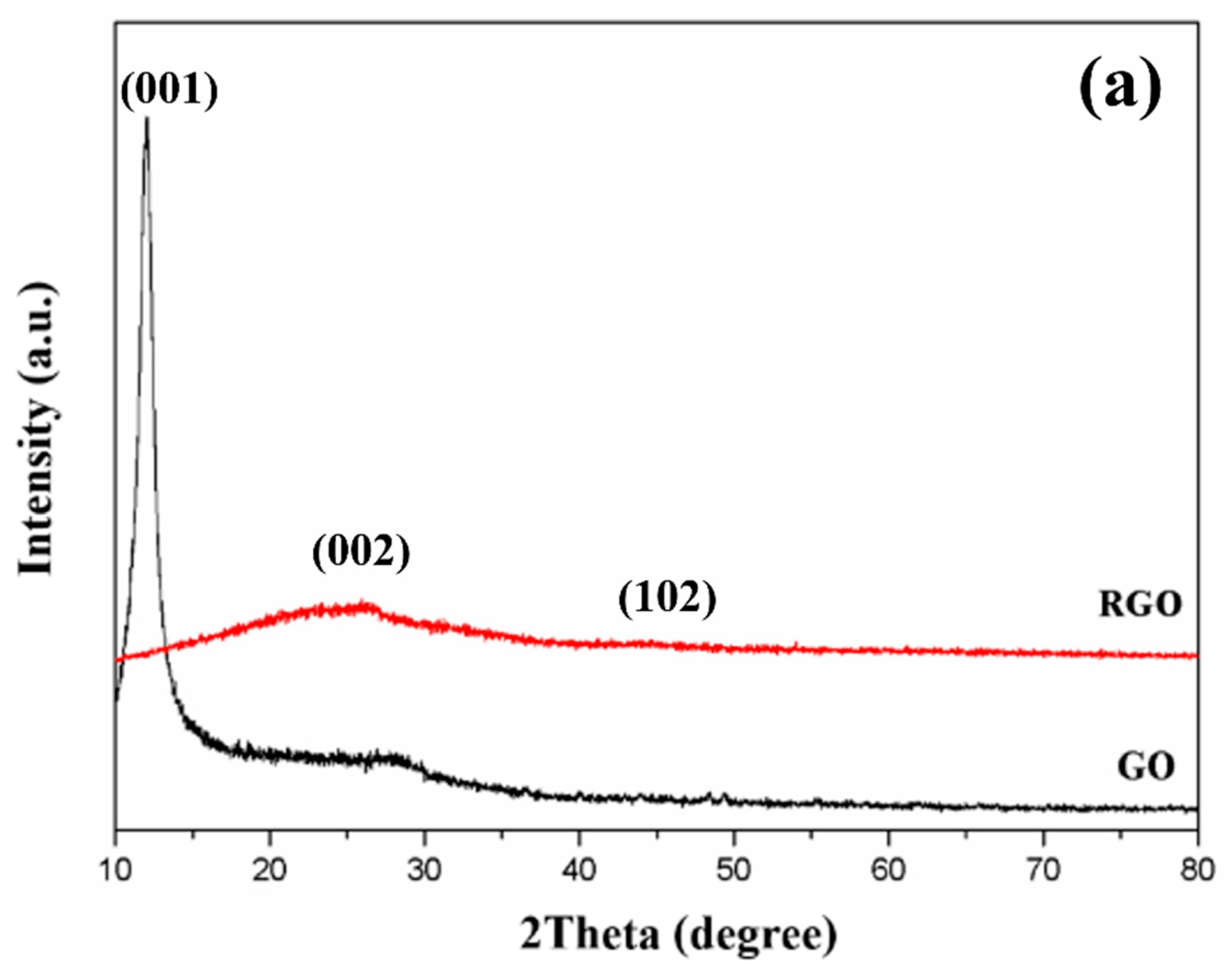



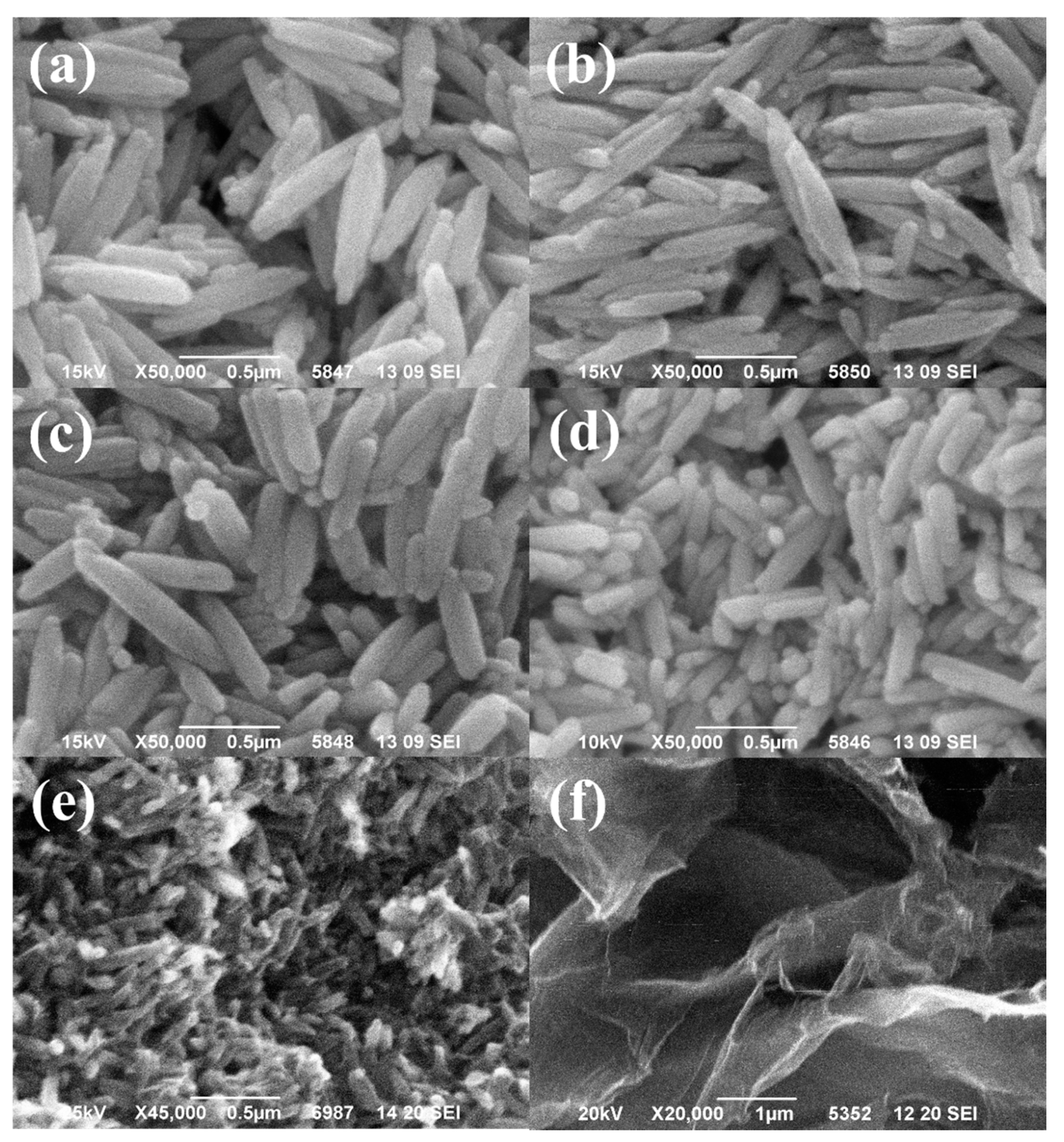
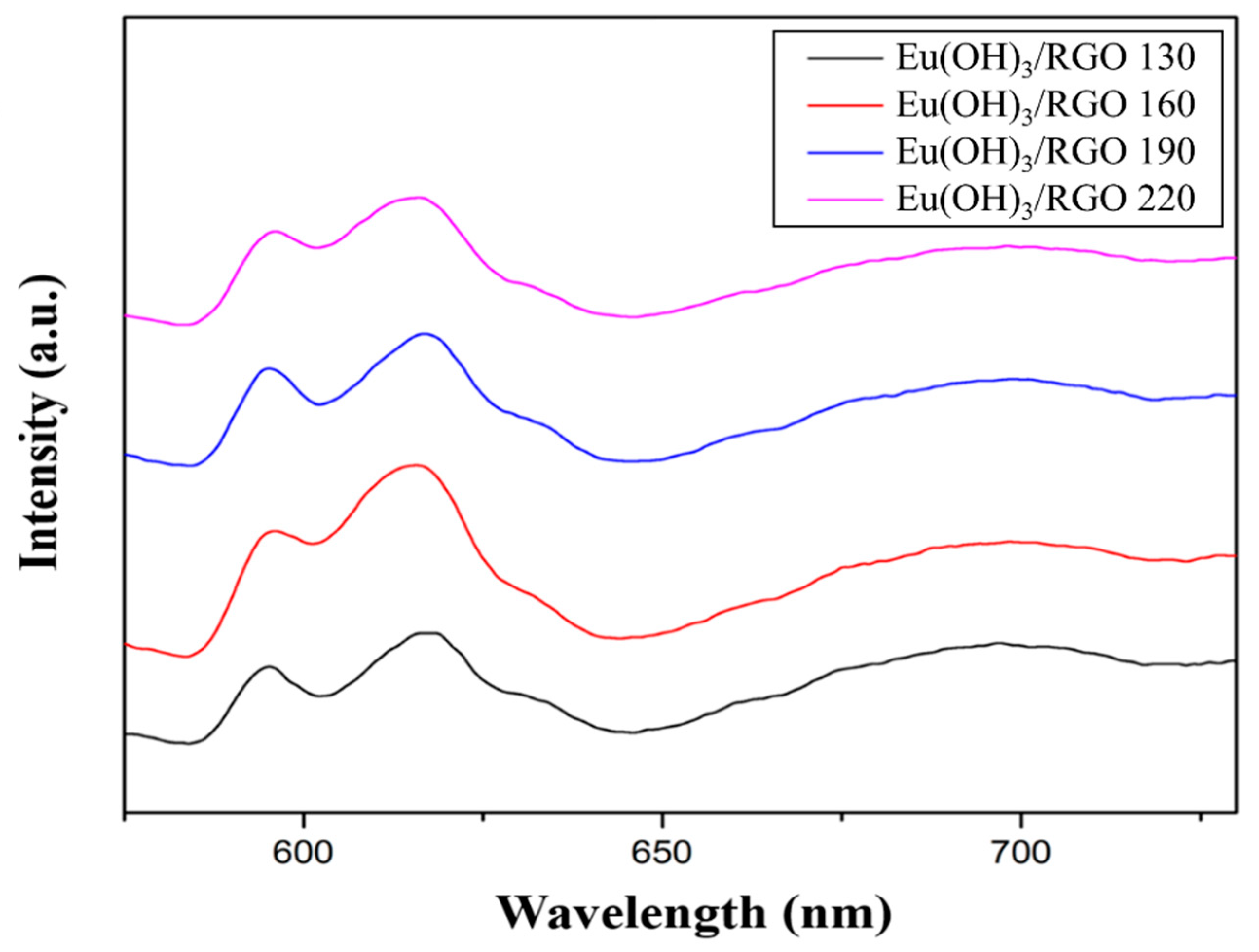
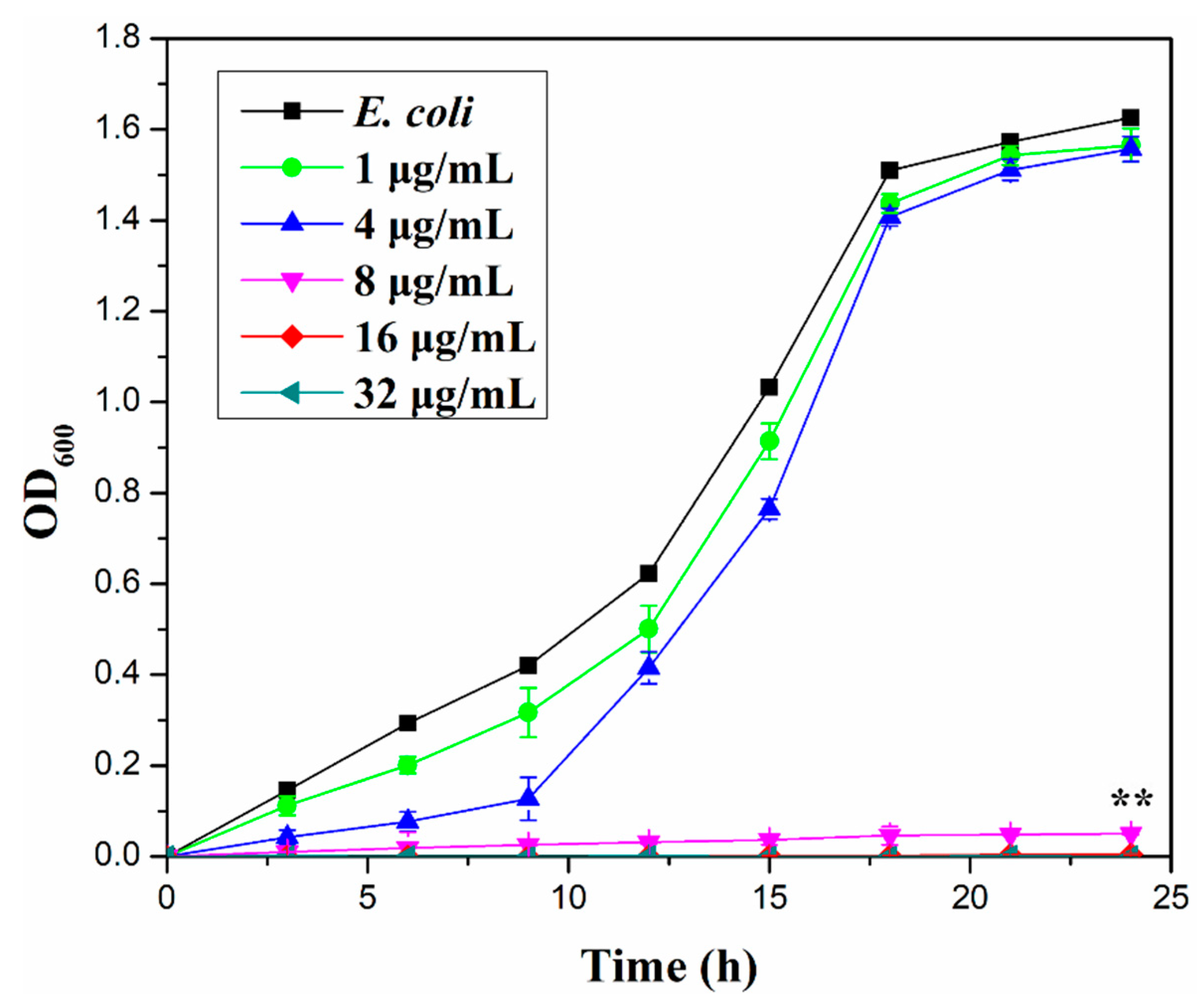
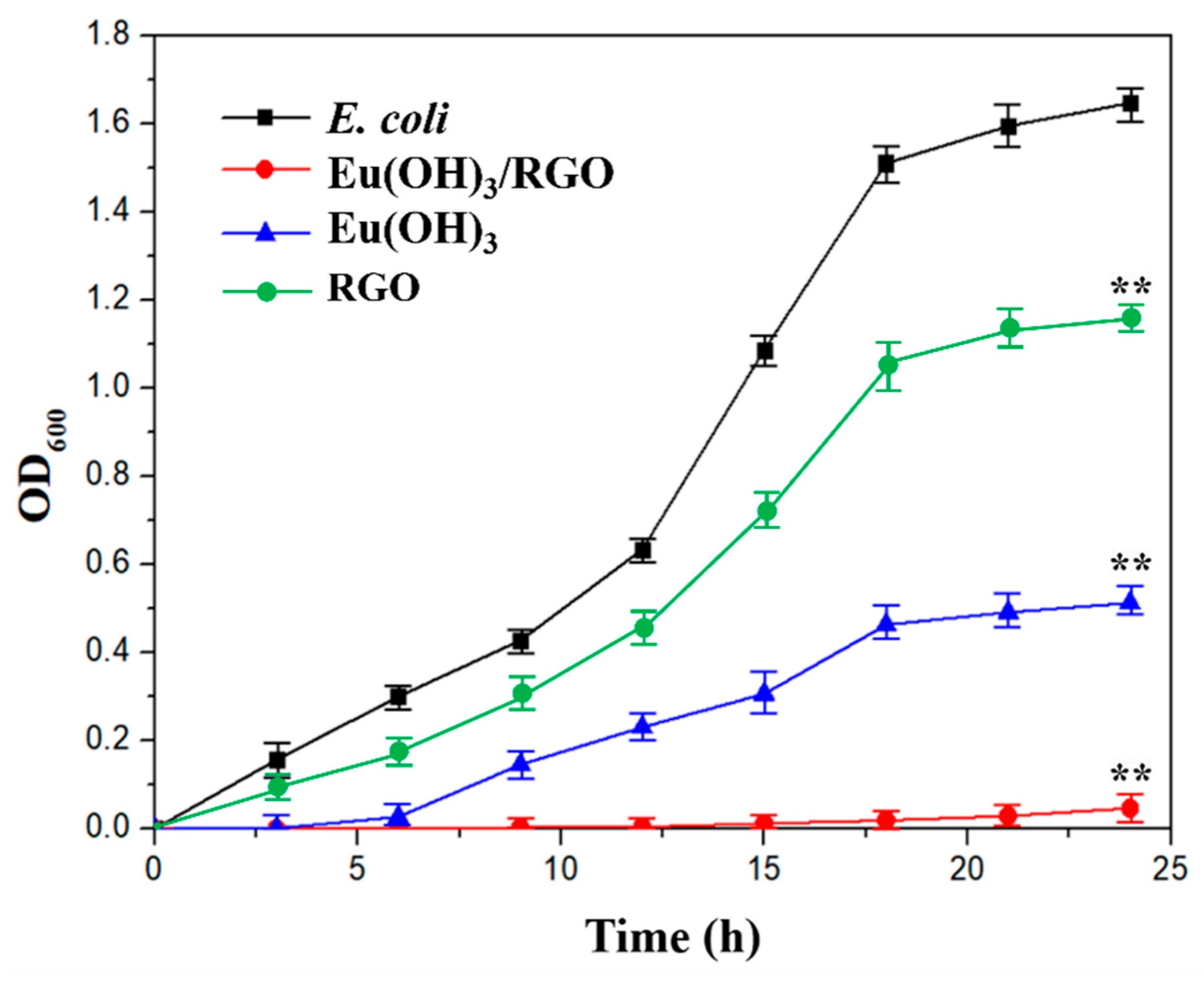
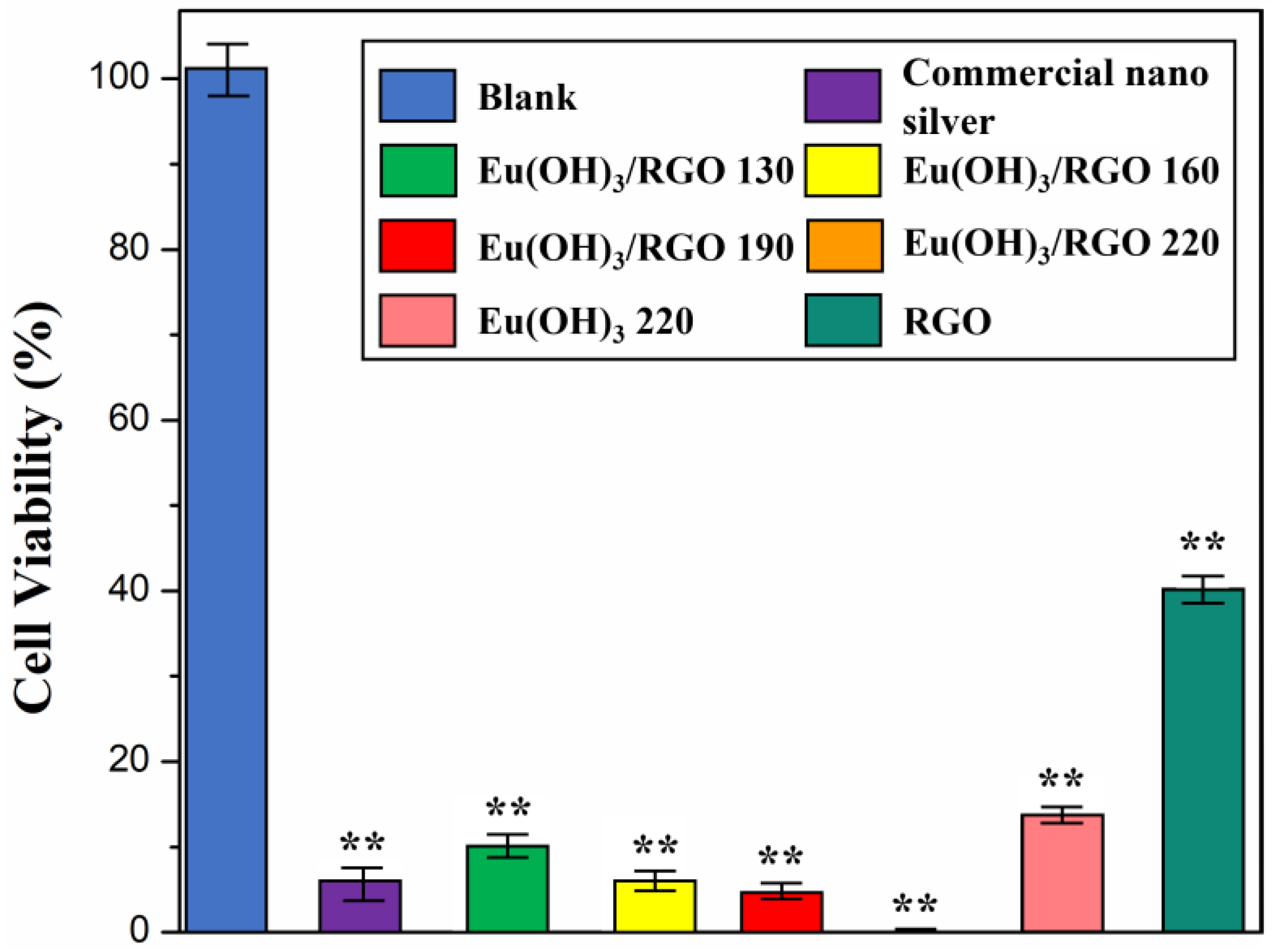

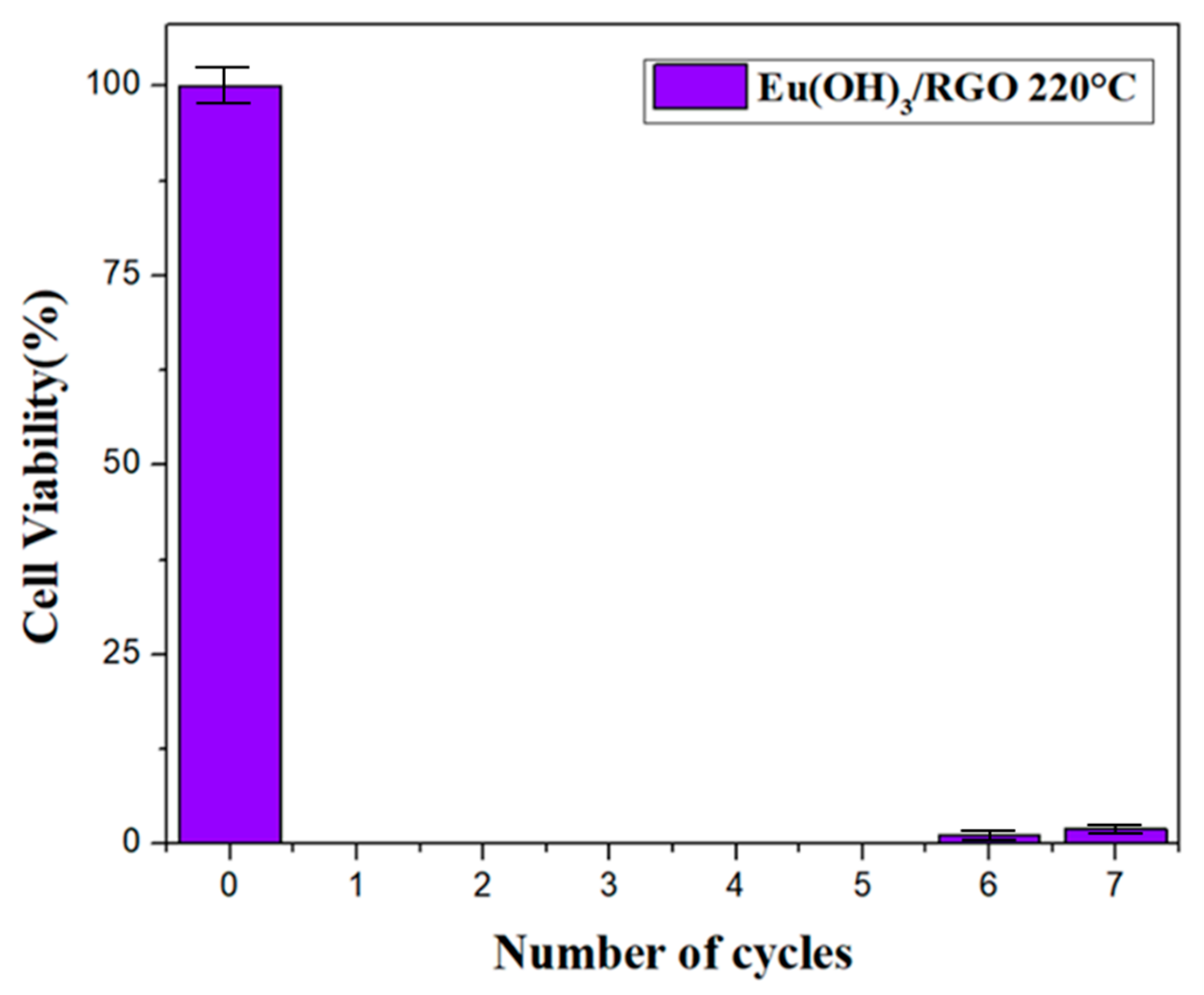
| Sample | Rod Length (nm) |
|---|---|
| Eu(OH)3 220 | 600 ± 9.8 |
| Eu(OH)3/RGO 130 | 630 ± 9.5 |
| Eu(OH)3/RGO 160 | 471 ± 7.2 |
| Eu(OH)3/RGO 190 | 158 ± 2.2 |
| Eu(OH)3/RGO 220 | 97 ± 2.4 |
| Bacterial Strain | MIC (µg/mL) | ||
|---|---|---|---|
| RGO | Eu(OH)3 | Eu(OH)3/RGO | |
| E. coli | 256 | 32 | 8 |
| Zone of Inhibition (Diameter ± SD (mm)) | ||||
|---|---|---|---|---|
| Ampicillin | RGO | Eu(OH)3 | Eu(OH)3/RGO | |
| E. coli | 18.3 ± 1.1 ** | 8.1 ± 1.7 ** | 15.0 ± 1.1 ** | 21.2 ± 1.8 ** |
Publisher’s Note: MDPI stays neutral with regard to jurisdictional claims in published maps and institutional affiliations. |
© 2021 by the authors. Licensee MDPI, Basel, Switzerland. This article is an open access article distributed under the terms and conditions of the Creative Commons Attribution (CC BY) license (https://creativecommons.org/licenses/by/4.0/).
Share and Cite
Shih, K.-Y.; Yu, S.-C. Microwave-Assisted Rapid Synthesis of Eu(OH)3/RGO Nanocomposites and Enhancement of Their Antibacterial Activity against Escherichia coli. Materials 2022, 15, 43. https://doi.org/10.3390/ma15010043
Shih K-Y, Yu S-C. Microwave-Assisted Rapid Synthesis of Eu(OH)3/RGO Nanocomposites and Enhancement of Their Antibacterial Activity against Escherichia coli. Materials. 2022; 15(1):43. https://doi.org/10.3390/ma15010043
Chicago/Turabian StyleShih, Kun-Yauh, and Shiou-Ching Yu. 2022. "Microwave-Assisted Rapid Synthesis of Eu(OH)3/RGO Nanocomposites and Enhancement of Their Antibacterial Activity against Escherichia coli" Materials 15, no. 1: 43. https://doi.org/10.3390/ma15010043
APA StyleShih, K.-Y., & Yu, S.-C. (2022). Microwave-Assisted Rapid Synthesis of Eu(OH)3/RGO Nanocomposites and Enhancement of Their Antibacterial Activity against Escherichia coli. Materials, 15(1), 43. https://doi.org/10.3390/ma15010043






